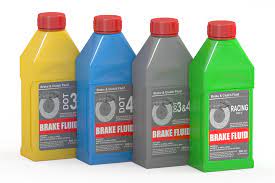
Without the presence of the brake fluid, your car would not come to a stop every time you press the brake pedal. The brake fluid enables the transmission of power within the car’s braking system, such that pressing on the brake pedal transmits power to the brake pads, which in turn lock the wheel, thereby stopping the car. That means, understanding the type of brake fluid you need for your vehicle is an integral exercise.
In this article, we look at four types of brake fluids you should know about.
Let’s begin!
The different types of brake fluid
One is able to identify the type of brake fluid using the DOT followed by a number. Here, DOT is an abbreviation for Department of Transportation. The number shows the level of boiling point for each type. Most cars in Kenya use DOT 4 or DOT 5. As you shop for lubricants, it is worth noting that different brake fluid types come with different prices. DOT 5 is expensive compared to DOT 4. As you factor the cost of owning a car, consider the pricing.
-
DOT 3 Type
This category of brake fluid is one of the most popular brake fluids. This type of brake fluid uses glycol ether. With a boiling point of 401 degrees Fahrenheit, this type has a lower boiling point. Racing at top speed, braking hard, towing, or accelerating downhill for extended periods shortens the lifespan of this type of fluid. American cars mostly use this type of brake fluid.
-
DOT 4 type
DOT 4 is another type of brake fluid you will often come across. Just like DOT 3, it is glycol-ether based but with a higher boiling point. Its boiling point stands at 446 degrees Fahrenheit. In its early life, DOT 4 type tends to have a high, stable boiling point but its boiling point sharply declines once the fluid starts to absorb moisture. DOT 4 comes in different versions, too. Mercedes and Volvo car types usually use DOT 4-Plus while BMW models use DOT 4 Low Viscosity.
Both DOT 3 and DOT 4 have an amber color. Also, DOT 3 and 4 can be intermixed in some cases.
DOT 5 and DOT 5.1 Types
-
DOT 5 Type
This type of brake fluid uses silicon-based fluids so as to achieve the high viscosity and boiling point. Its boiling point averages 500 degrees Fahrenheit. Unlike DOT 3 or 4, it has a purple color. DOT 5 is different from other varieties because it is does not absorb water and it has a high boiling point.
With hydraulic fluids, the higher the boiling point indicated by the number, the more effective the brake fluid. That’s why technicians use DOT 5 with ABS systems
-
DOT 5.1 Type
There is yet another variation of DOT 5 – the DOT 5.1 brake fluid type. DOT 5.1 use glycol-based fluids and its color ranges from clear to amber. In other words, DOT 5.1 brake fluid types are DOT 4 brake types that meet the performance level of DOT 5. That means DOT 5.1 can be intermixed with DOT 3 and DOT 4 type of brake fluids.
Final Thoughts on Types of Brake Fluids
As a rule of the thumb, experts recommend that you change your brake fluid every one to two years. Regardless, check what your manufacturer recommends. As long as air and moisture don’t come into contact with the brake fluid, the brake system will most likely function without any noticeable performance difficulties.
Also, to change your brake fluid, it is advisable you leave that job to a trained mechanic. If you are not knowledgeable about the systems of car and how different brake fluids combine, it is wise you leave the job to a trained mechanic.
Next Read: Brake Fluid Leaks: Signs Your Car is Leaking


[…] Next Read: Types of Brake Fluids Every Driver Should Know. […]